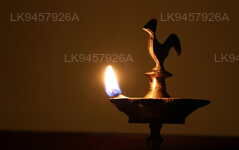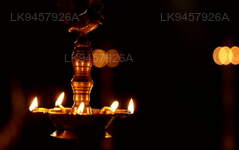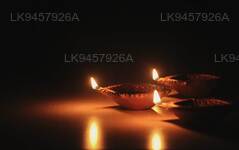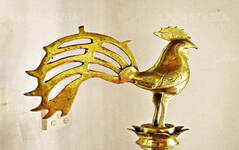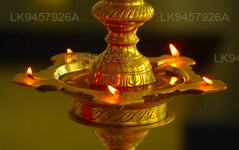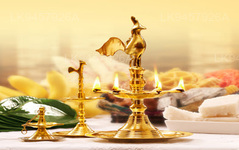Traditional Sri Lankan Oil Lamp
Lamps have played a significant social, cultural and religious role in the lives of Sri Lankans. Every important function, ceremonies or festivals across religion and culture, light the oil lamp is one of the most important event, including every event in the Embassy of Sri Lanka in Jakarta . The oil lamp is intricately linked into a person’s life; from their birth, to their marriage, known as the second birth of a person and death. The flame of the lamp stays lit unfailing through all these times weaved into the rhythm of people’s lives.
Fire, since pre-historic ages, has been an integral part of our lives. At times as a figure of worship and at times as a necessity, it has taken many forms throughout the centuries. And, carrying this flicker of light, the oil lamp in its many shapes, sizes and uses has become a symbolic element deeply intertwined with our culture.
As to how the oil lamp found its way in to the daily lives of Sri Lankans, we can look to its neighbours, India, for answers. They set fires in the confines of their dwellings as a religious ritual. The worshipers believed that these fires to which they added milk and ghee, served as a mode, carrying with its fragrance their heartfelt yearnings and wishes to the heavens above. However, by and by these fires grew less in number and instead of representing the roaring fire, small lamps were made to light and worship the deities as is prominent with the Aarthi pooja. Though the fires, known as yaham, did not cease, the oil lamp came to hold a different and deeper meaning in its veneration. Through time the lamp had become a source of light, illuminating a household, an aesthetic aspect that sets the ambience, be it at a religious abode or house, and a means of devotion.
The the usage of oil lamps has been found at the Dedigama Kota Vehera. Belonging to the Polonnaruwa era, in 12th Century AD, the lamp is thought to have been made during the reign of King Parakramabahu. Known popularly as the elephant lamp, it is a hanging lamp made of bronze with an elephant and a rider on its broad back, standing in the midst of a basin that could be filled with oil. Further, the stomach of the elephant also acts as a vessel for holding oil, while a foreleg of the animal serves as conduit to pour the oil. As the oil levels of the basin dip low once the lamp is lit, through a hydraulic pressure system more is supplied from the excess oil stored in the elephant’s stomach. Such is the unique technology that was available in ancient Sri Lanka.
Influenced by the many South Indian princes and princesses that arrived in the country along with their brass-workers in tow, the oil lamps of Sri Lanka became more intricate works of art. Images of dragons, roosters, peacocks, liyawel, lotuses and other delicate articles were added to lamps that grew heavier as well as taller and bigger. More variations were incorporated, as from that time on oil lamps included standing, hanging and table lamps just to name a few different types. During the Kandyan period, oil lamps had evolved creatively, technologically and had incorporated aspects of other cultures. An extensive oil lamp collection can be seen at The National Museum of Colombo.
Nowadays oil lamps include simple designs. With the much prominent rooster on top, these are easy to polish and maintain, though much of the Kandyan era features have been preserved. The rooster is said to be the most ideal to be placed on an oil lamp, as it announces the dawn of the day just as the oil lamp brings light to peoples’ lives.

